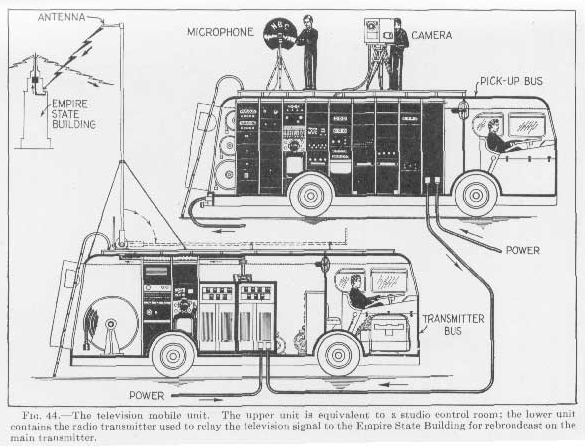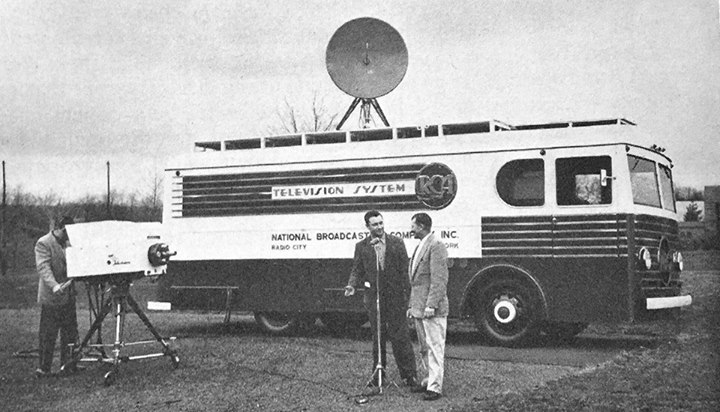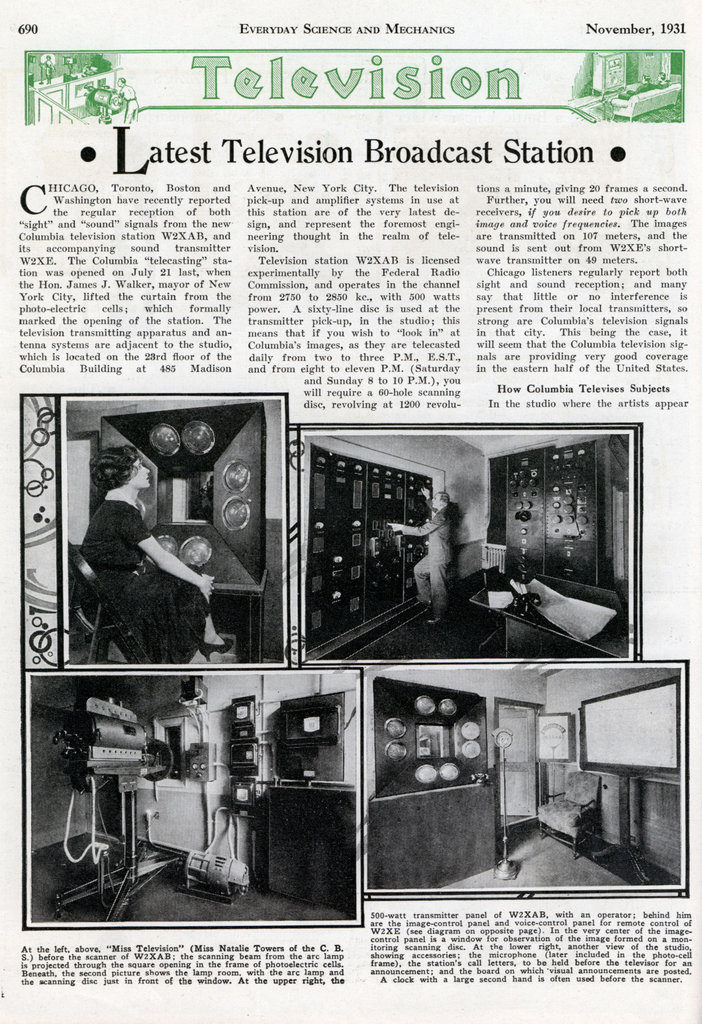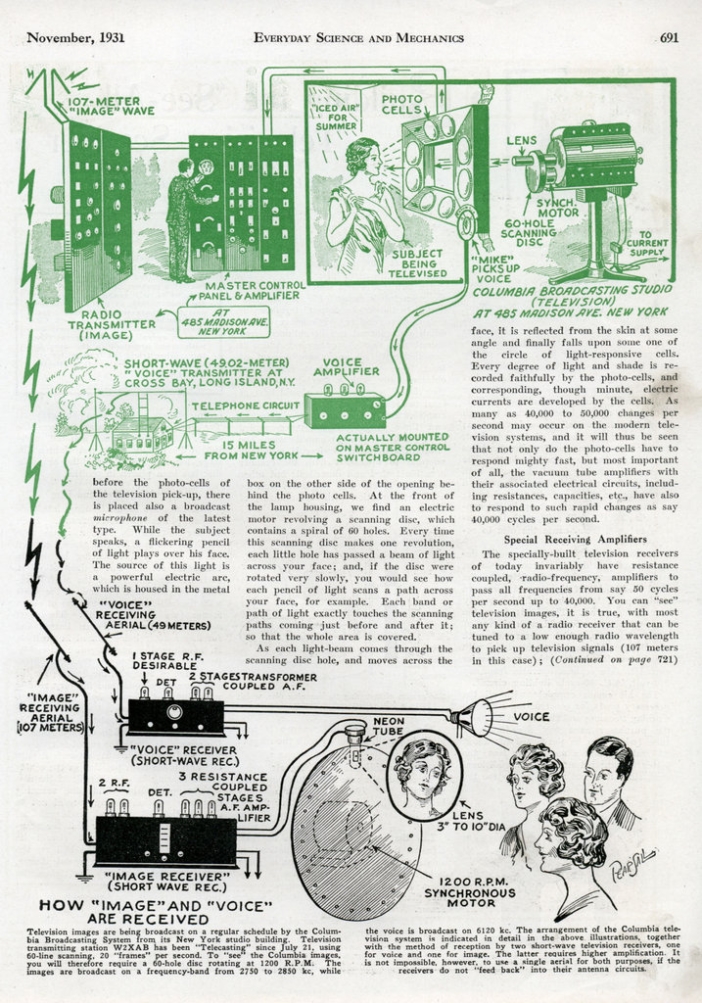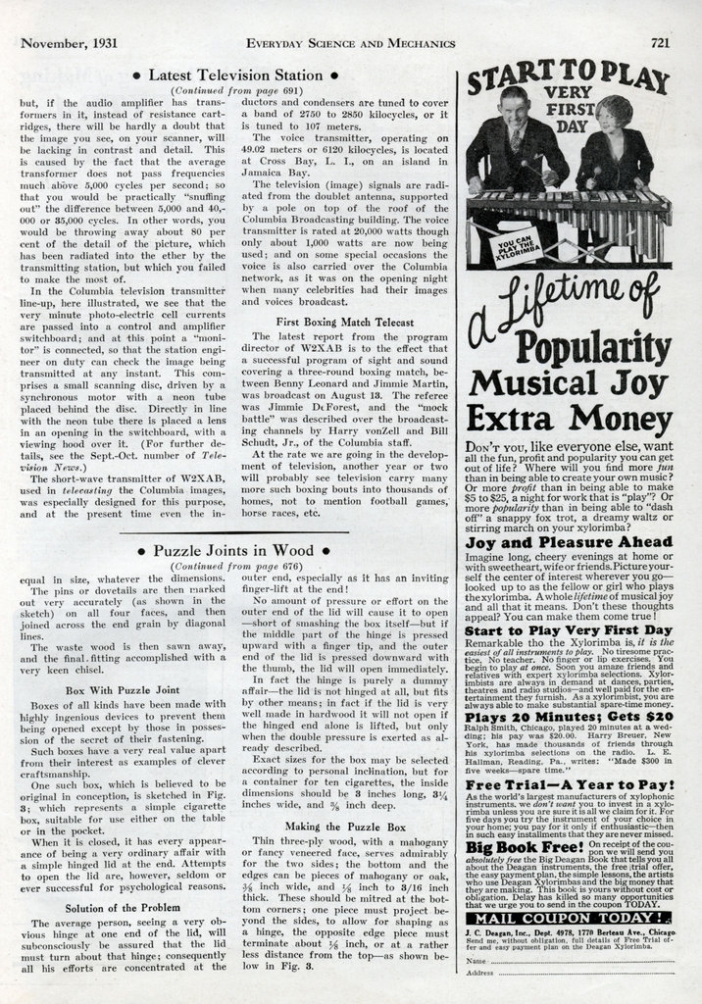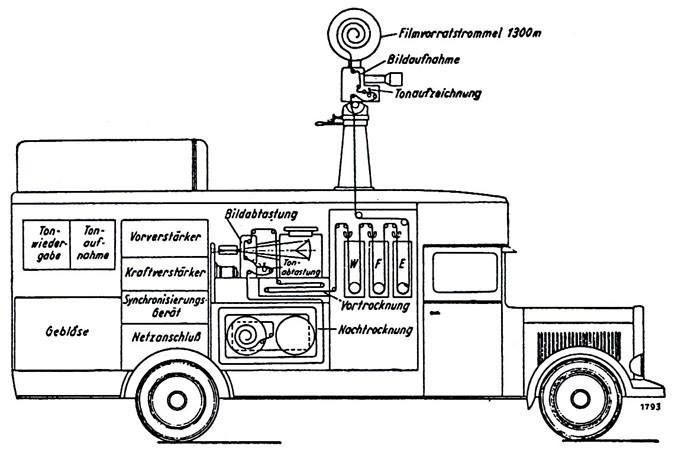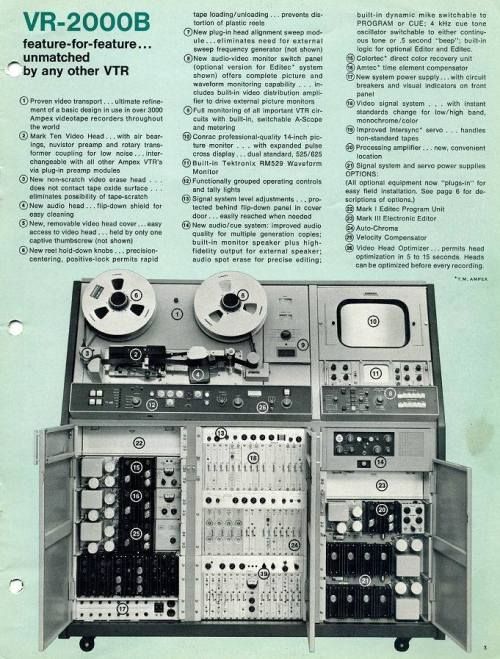
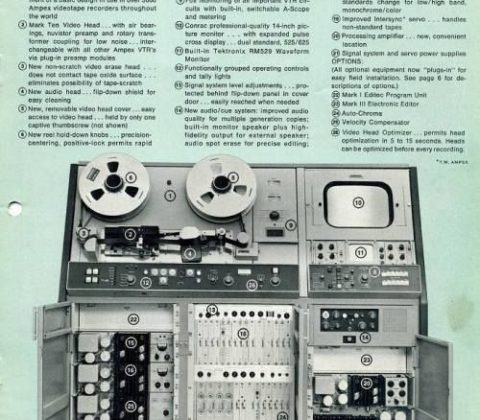
Video Tape…Images With Impact
This 23 minute presentation is a fine historical tutorial on early videotape editing, all the way from the jump cut developed on NBC’s “Laugh In” to the electronic video editing of the 70s and 80s.


December 12, 1937…America’s First Mobile Units Delivered
On December 12, 1937, the world’s first electronic television remote units were delivered by RCA to NBC in New York City. The dual vehicle system, consisting two, 26 foot buses included one for production and one for transmission.
The production bus provided two portable single-lens Iconoscope cameras and the support equipment. The transmission bus contained the transmitter with a 50 foot antenna which could relay a remote pickup to the Empire State Building from as far away as 25 miles.
The units were field tested for about six months before being returned to RCA’s Camden plant for modifications in the synchronizing equipment. Another modification was the installation of an coaxial feed out the transmitter truck, which allowed them to shoot at 30 Rock’s sunken ice skating rink.
The trucks came back in late August, and on September 15, 1938, W2XBS began a weekly series produced entirely from the trucks. The “Man On The Street” show interviewed passers-by at different locations each week up until the 1939 World’s Fair opening in New York. By the time the World’s Fair came to town, NBC had a lot of experience with the units and used them heavily there.
Also shown here is the world’s first color mobile unit, which used one of these original 1938 trucks as part of the experimental field testing of color broadcasting. Although the interior had been totally retrofitted with all new color equipment, the use of one truck was now possible becuase of new, improved microwave equipment. The date for the conversion is early 1951.
I have seen photos of these trucks with RCA TK30s, which would put them in use in 1946, and I suspect they were used locally as a black and white unit until NBC bought new, larger bus units around 1950. Unfortunately, no one knows what became of them. -Bobby Ellerbee


The Heidi Bowl…The REAL DOCUMENTS & DETAILS!
November 17, 1968…’Heidi’ Trumps The Jets – Raiders Finale On NBC
Did you see this live? I did…I had just turned 18 and that Sunday night, I learned a new word from my dad, which I can’t repeat here. This was AN EVENT like no other in television sports and there are stories on top of stories, and further below is a very good video that explains what happened BUT FIRST, THIS!
Recently, Rob Weir has shared these documents from his dad’s archives that give us the REAL INSIDE STORY! His dad was Jack Weir and at the time, was Director of Broadcast Operations and Communications at NBC New York.
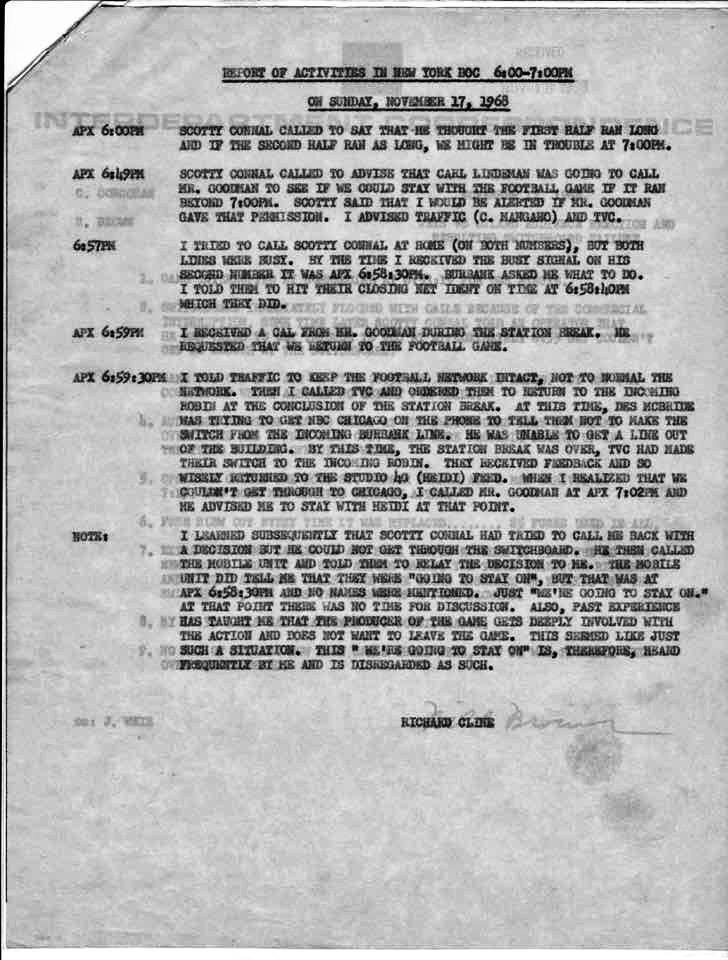
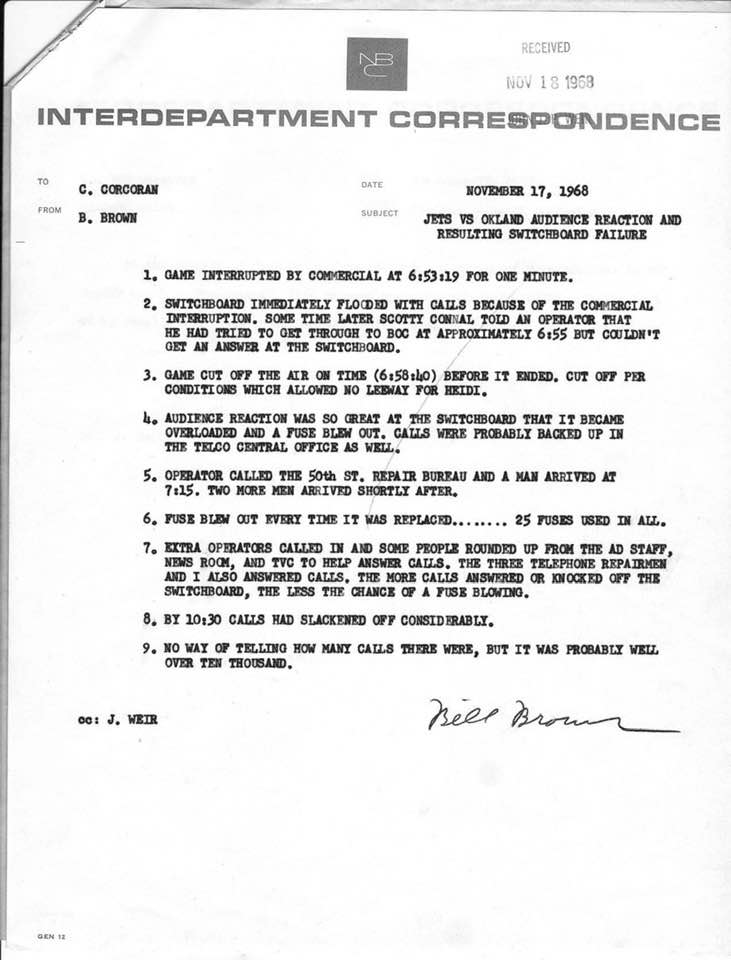
For all intents and purposes, it looked like the Jets had won and with only a minute left, there was no way for an Oakland comeback…BUT, comeback they DID! Here’s a great video recap of what happened and how it happened.


NBC Tour Book: 1939 World’s Fair…America’s View of Television
The first big push to bring television to the public’s attention was mounted by RCA at the 1939 World’s Fair in New York. This is a rare survivor…the 32 page tour book handed out at the RCA Pavilion, that attempts to cover many aspects of the new media. It is packed with rare photos and maps, that even show the Alexanderson Mechanical Disc Camera from the early 1920s, and the later version of that technology, complete with the famous Felix The Cat scanning camera on display. Enjoy!
Studio 8H and the Chapman crane
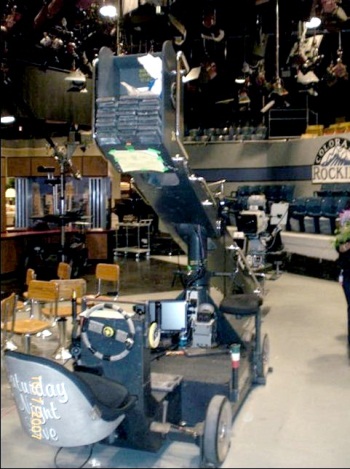
Among the very few things that have not changed since Saturday Night Live debuted in 1975 are the studio it originates from, and the constant use of this Chapman Electra stage crane on the show. We’ve all seen it a thousand times, but never like this before.
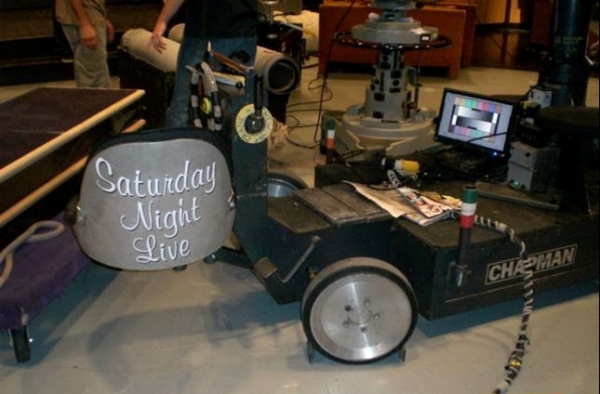
Above is the driver’s seat, and you can see the flat panel monitor that shows the driver the camera feed as the crane is moved. Only the rear wheels turn to steer, and you can see the brake pedal that stops the battery-powered rig. Below is the view from the driver’s seat up the boom arm, showing the boom operator’s monitor.


Above, we see the camera operator’s perch and the foot controls used to turn the turret plate the camera and seat are mounted on, which rotates 360 degrees. Below is another great shot of the camera turret with the boom all the way up. Can you say “catbird seat”?
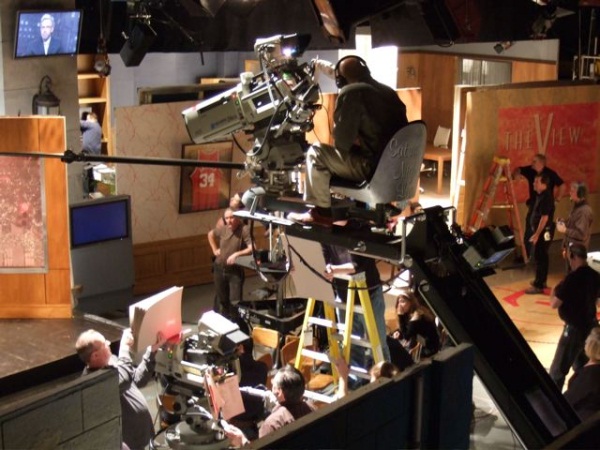
SNL comes from NBC Studio 8H on the 8th and 9th floors of 30 Rockefeller Plaza. As pictured below in this 1939 Life article, 8H was built in the 1930s as a radio soundstage, and originally seated 1250 people. Promotional materials of the day often called 8H the “auditorium studio.” Its most famous tenant was Arturo Toscanini and the NBC Orchestra. In 1950 it was converted to a television studio.
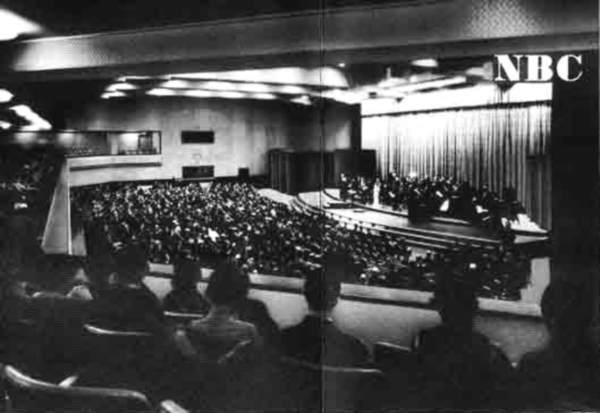
When the show started in 1975, it was decided SNL would originate from 8H. There needed to be a crane for all the frenetic movement in this very busy show, and the Chapman Electra was selected. It has called 8H home since 1975, but it is occasionally used in other studios because when the boom arm is removed, it can fit in the NBC freight elevator to move between floors.
Although 8H has been SNL‘s home since ’75, it too is also used for other productions and events, such as the Summer Olympics from China in 2008. Below you see you see two photos of the 8H studio floor covered with temporary announce booths. Each booth has a producer’s room and a larger announcer’s room where two or even three announcers watch the live feeds from China and add their commentary.

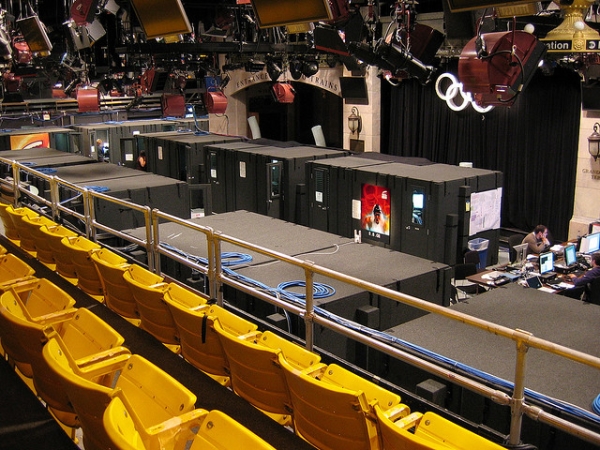
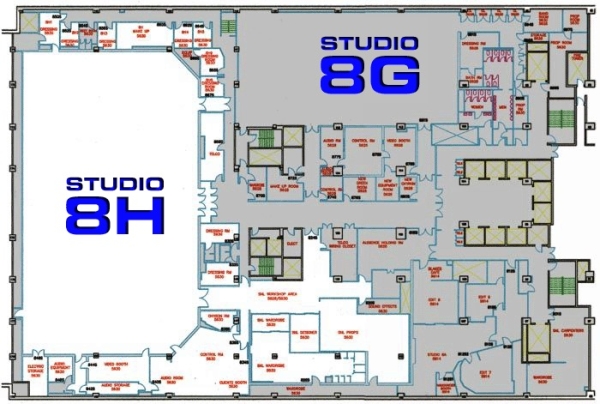
As you can see in the diagram above, 8H and 8G are side by side. Occasionally, the Chapman works there for projects like national election coverage. Below are two shots from 1978 showing Studio 8H in preparation for a new season of SNL (top) and in 8G, the new election set is getting final, last-minute touch-ups and making ready for camera rehearsal (bottom). With so much action in SNL broadcasts, crane shots are essential, but even in situations like election coverage, the unique visual aspect they offer makes a big difference by adding motion abilities the pedestal cameras can’t. Crane shots make static shot situations more fluid with even a small degree of movement.
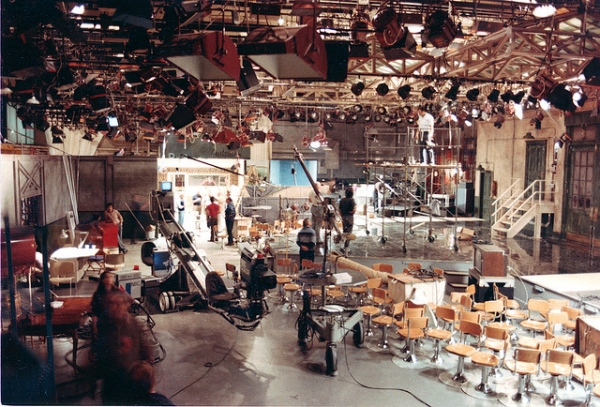

Now, it’s time to take a closer look at where the rubber meets the road – literally! Notice the front wheels have two sets of wheels: one set pneumatic and one set hard rubber. The back/steering wheels are single hard rubber wheels. The reason for the dual-form tire arrangement is to give the smoothest possible ride. The single front hard rubber tire gives a firm ride and single front pneumatic gives a softer ride, but together, they give the best possible “Goldilocks” ride: not too hard, not too soft. I’m sure the cable guards come in handy, too.
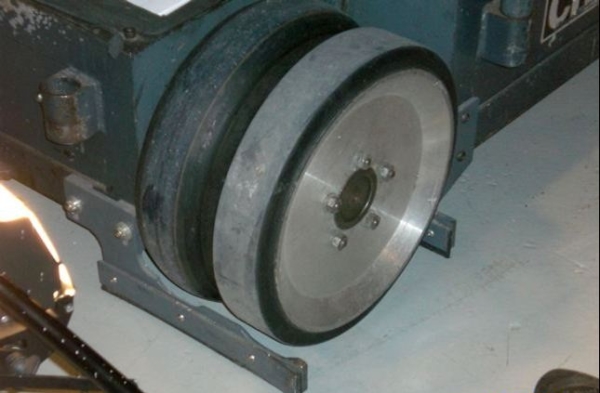
Operating the crane is basically a three-person operation requiring a driver, a boom arm operator and a camera operator. Below is an amazing time-lapse video of Saturday Night Live in production. Much of it was shot from small cameras mounted on this crane. Interestingly, there are two boom arm operators.
I’ve said on other pages of this site how glorious it must be to run the camera on a Chapman…sheer fluidity and grace in motion. Speaking of motion, here is a schematic that shows this crane’s motion capabilities.

Now, here of some shots of what feels like an old friend…one we’ve known for years. I’m sure many of us would love an hour in John Pinto’s chair. He’s the cameraman, and we’ll meet him below.
The camera shown is a Sony HDC 1500 in the Sony HDLA 1505 build-up kit. In the images below, you’ll see the camera folded back into the boom arm while it’s not in use.
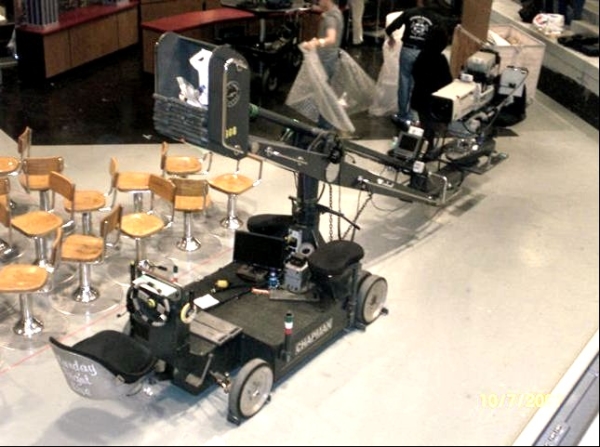
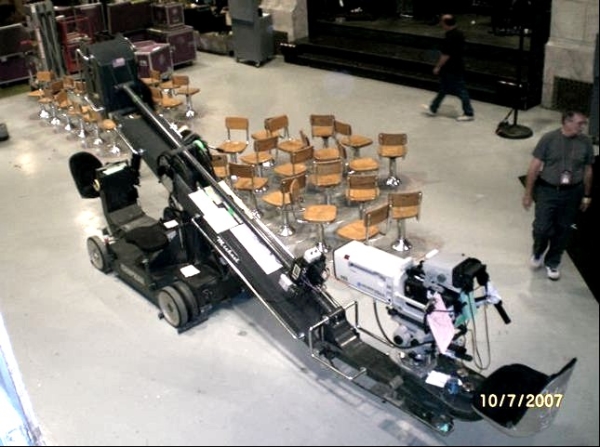
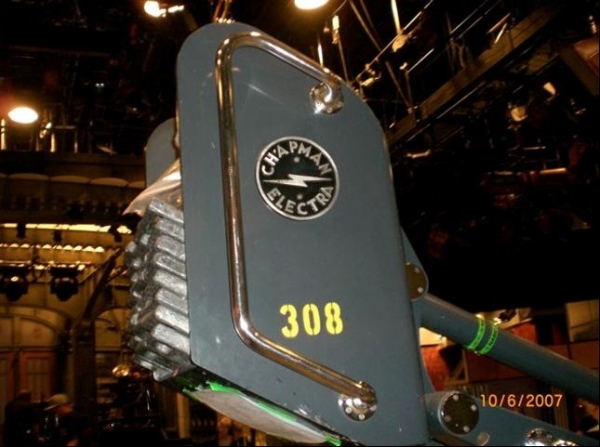

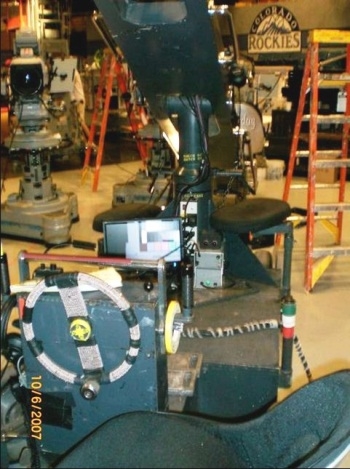
Now that we’ve met the Chapman Electra, let me introduce you to one of the luckiest men in television…the man who gets to ride it. Meet John Pinto.
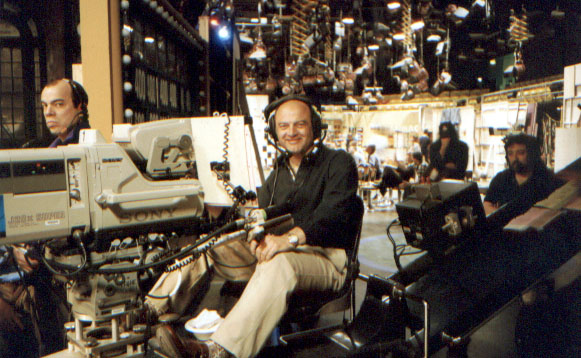
In 1975, the show Lorne Michaels and Dick Ebersol were developing became a reality. Aside from casting the “Not Ready for Prime Time Players,” the staff casting was going on too. NBC set out to recruit a hip, young, but professional crew…and got it. Among those hired were John Pinto, who was at ABC, and Jan Kasoff and Al Camoin, who were at NBC’s Brooklyn studios, and they stayed for many years. John is still there, but more on John and Jan below.
The first camera in use on SNL was the TK44. Below, we see one on the Chapman, possibly operated by Al Camoin, the original crane cameraman.
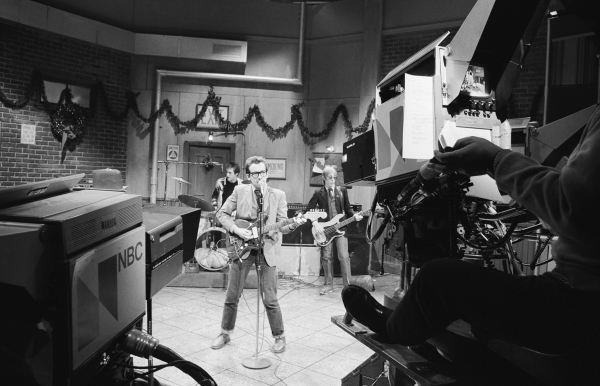
The next camera in use at SNL was the TK47. Below are two shots of a 47 on the Electra, with John at the controls.
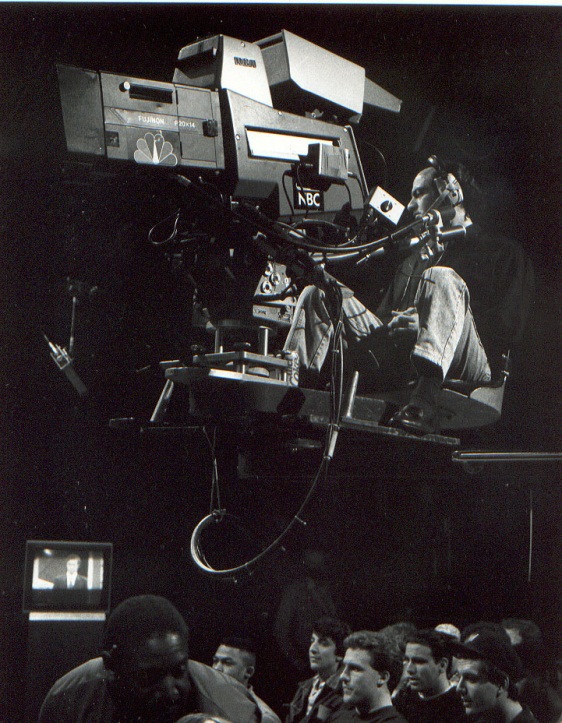

I wanted to put this next image further up the page, but held it for here so I could make the comments I want without veering from the Chapman story too much. Now I can say what I was thinking when I first saw the image below, and what it reminded me of.
Before you read further, please take a moment to really look at this photo and see if you see what I see.
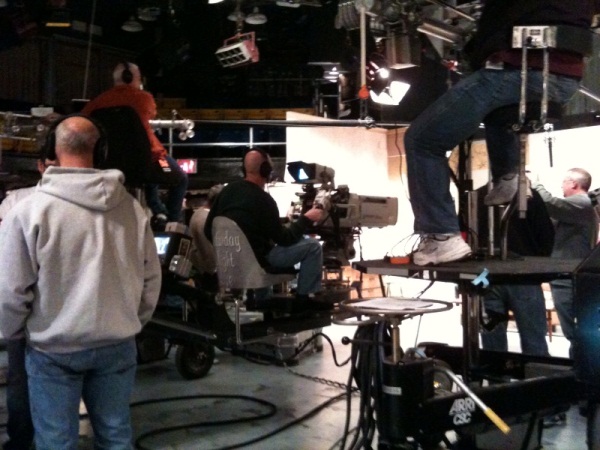
At first, I saw just the camera. But then, to my amazement, I also saw perambulators…yes, sound booms. Two of them! Did you notice them in the pictures above? No? Neither did I, but they are there if you look. Then, a shoe dropped.
I thought, wow. How did I not notice the use of these pieces of equipment that were so vital to television just yesterday, but so unique in studios today? Then the other shoe dropped…the big one. Do you have any idea what that epiphany was?
The people! If you visit almost any local TV station these days, the only people you’ll find in the studios is the talent, and maybe a floor director. Yes, there are news cameramen in the field with ENGs, but robotic pedestals and wireless mics have killed the studio crews.
Thank God there’s still production value at SNL that only skilled and experienced humans can satisfy. Only the networks are keeping the art of camera work alive in the studio and in sports. Thank you!
That is not the first time that has occurred to me. It’s one reason for creating Eyes Of A Generation: to memorialize and pay tribute to the behind-the-scenes people…and to all of you, past and present, thank you!
Many thanks to Greg Hill for the images and information. Greg is Operations Manager for Chapman – Leonard, the world’s leading name in cranes and camera support since 1945. Thanks also to Dennis Degan for his great images of 8H, and to the NBC staff in New York who helped with some background details, including John Pinto and Jan Kasoff. You’ll meet Jan below.
One final note on cranes. Just so we don’t forget the Electra’s predecessors at NBC, I’m adding these images.
Below top is the Sanner studio crane. I think this debuted around 1948, just after the TK10/30 came out. The picture from WKY in Oklahoma City was taken in 1950 and by then, they were in wide use at well-heeled local stations and at the networks. CBS used them in New York longer than NBC, but as you see below, one of NBC’s Sanners is hard at work on Your Show Of Shows with Sid Caesar. RCA listed this Sanner in its catalog as the TD-6A.
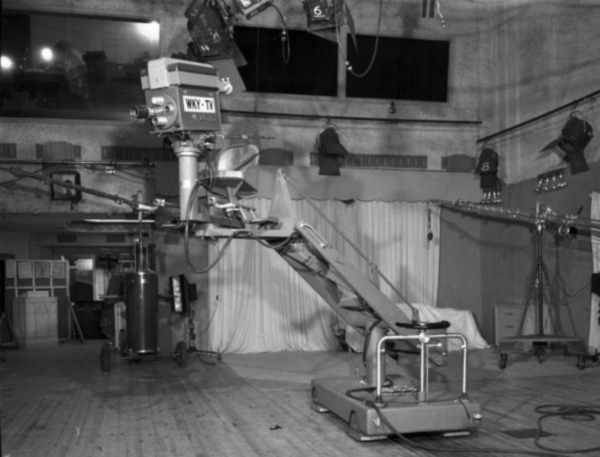
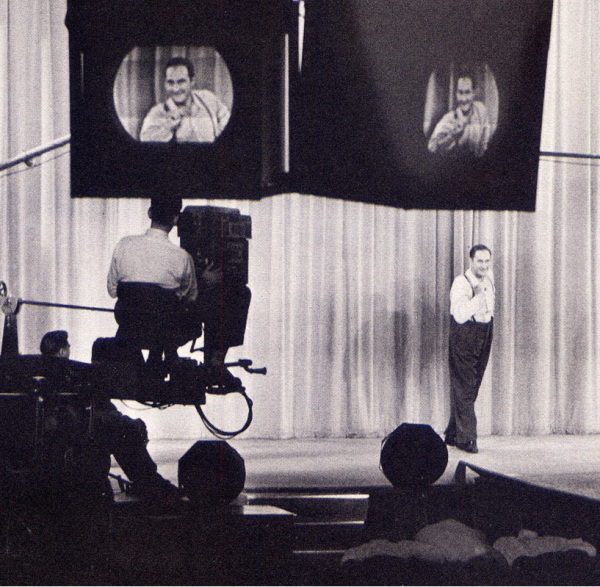
Below, the great Houston Fearless 30B stage crane that I think came out around 1954, and was built to handle the weight of the new color cameras.
NBC had several of these at 30 Rock, at the Brooklyn I and II studios, and at the Ziegfeld Theater for Perry Como. Burbank had several, too. NBC went to the 30B much earlier than CBS, probably because NBC had a lot of TK41s and CBS did not. I’ve never seen a TK41 on a Sanner, and don’t think it would bear the weight. When CBS added color at Television City, the network bought several 30Bs and used them under the TK11s, too. I think the 30B is beautiful – it kind of has an art deco look to it.
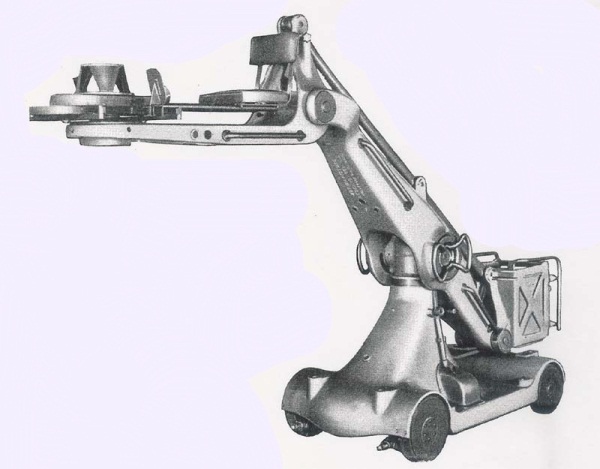
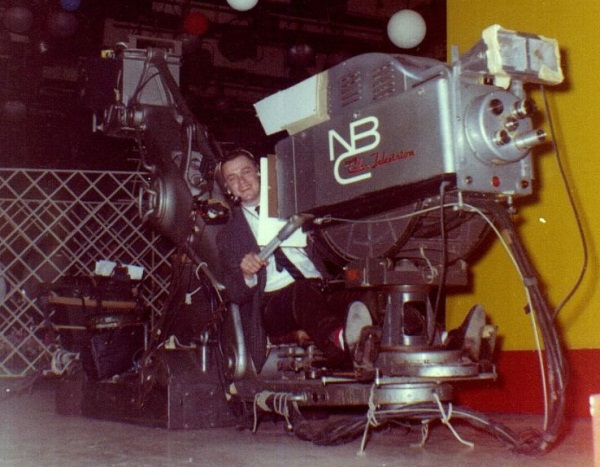
Above is 36-year NBC veteran cameraman Jan Kasoff. His TK-41 is mounted on an HF 30B in use at NBC’s Brooklyn studios in a photo from around 1968. Jan started full-time with NBC in 1967 and until 1978 he worked on soap operas, game shows, sports, news and more. Jan did his first Saturday Night Live in 1977 to cover for a cameraman who was out. He was asked to do SNL as a regular in ’78 and continued there for the next 26 years as a permanent member of the SNL crew until he retired in 2001.
After a six-month hiatus Jan came back to do the show for another year and a half until he became a Florida snowbird. He did his last Saturday Night Live in March 2003. After his second retirement, NBC continued to ask Jan back at busy times; he would return to work NBC Nightly News and other programs. He did his last assignment for NBC in November 2008, when the Florida winters became just too good to pass up. Below, we see Jan on the SNL set just before show time.
Jan got his start by doing what a lot of us used to do: apprenticing. He was around The Perry Como Show set at the Ziegfeld Theater in New York a lot and made himself useful to the staff and crew. He was raised on the TK41s and was one of NBC’s top color cameramen. That camera brings back a lot of fond memories for Jan, and he would just love to have one in his den, but don’t mention this to his wife. (If she complains, Jan, tell her you want the crane, too. That should do the trick.)
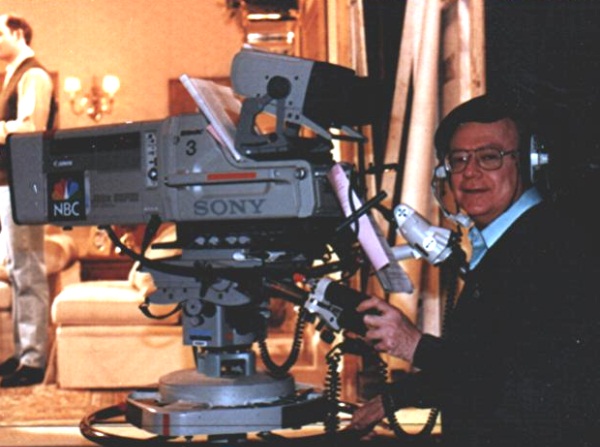
One final thing. Here is a table of productions done at NBC New York, showing the studios they come from and some interesting notes. Thanks to Wikipedia.
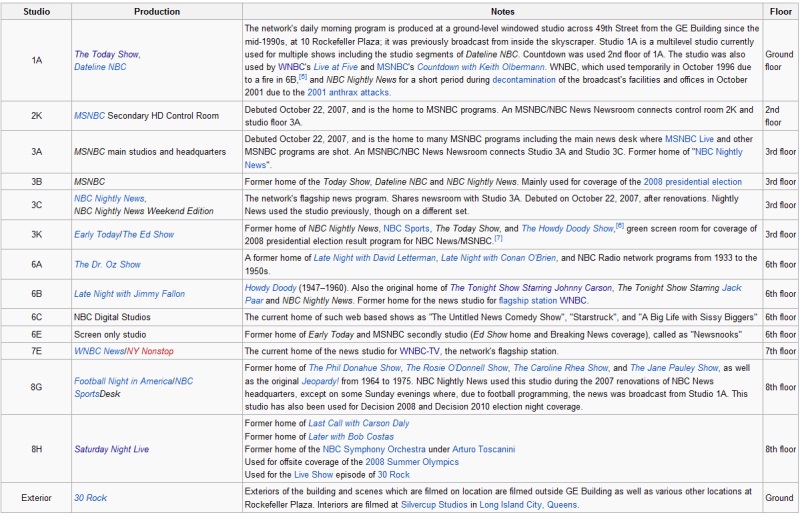
1931: Tour Of CBS Experimental TV Studio, W2XAB New York
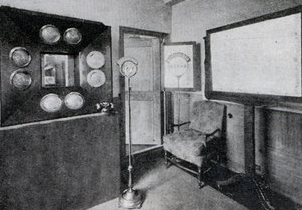
Complete with pictures and drawings, this 1931 article from Science and Mechanics takes us on a tour of CBS’s W2XAB facility in New York…one of the first experimental television stations in the U.S.
The Birth Of The Camera Mounted Electronic Viewfinder
With all of RCA’s incredible advances and discoveries in television, you would have thought that they would be the ones to put an electronic viewfinder into a television camera, but no…they weren’t. The first production cameras made by RCA and DuMont used Iconoscope pickup tubes but RCA did not add an electronic viewfinder until the prototype versions of their Image Orthicon cameras. RCA had a second optical lens above the taking lens that fed and upside down optical image onto a ground glass plate inside the top of the camera. As you can see below, that could be pretty confusing to the cameraman. For more on the RCA camera click the link. https://eyesofageneration.com/some-little-known-facts-of-early-television-production-yesterday-i-posted-t/

What you will see here is what I believe to be, history in-the-making in this sequence of rare photos that would have been totally overlooked had Barry Mitchell not sent them to me.
I feel pretty sure that what we see here in the photo below, is the first ever image of DuMont’s Iconoscope camera. The DuMont prototype camera.
The photo is of a demonstration of how an electronic television broadcast can go mobile, without even a mobile unit. This photo is from the November 1941 issue of International Photographer Magazine (page 351).
With a setup and body style (https://www.earlytelevision.org/emi_emitron.html) very similar to the BBC’s prewar Emitron cameras, this DuMont prototype camera had only an optical sighting hole. Although you can’t see it here, in the third photo down, you can see a ground glass style viewfinder port on the rear, similar to the RCA style on their prewar iconoscope cameras.
Behind the camera operator is the engineer/utility man and notice that he is looking into an electronic viewfinder (with a veiwfinder hood no less). The photo was most likely taken on the DuMont plant grounds in Passaic N.J., just weeks before Pearl Harbor. As a side note on the date, at this same point in history, brand new NBC Studios 6A and 6B were nearing the end of construction and were being readied for radio broadcasts at 30 Rock.
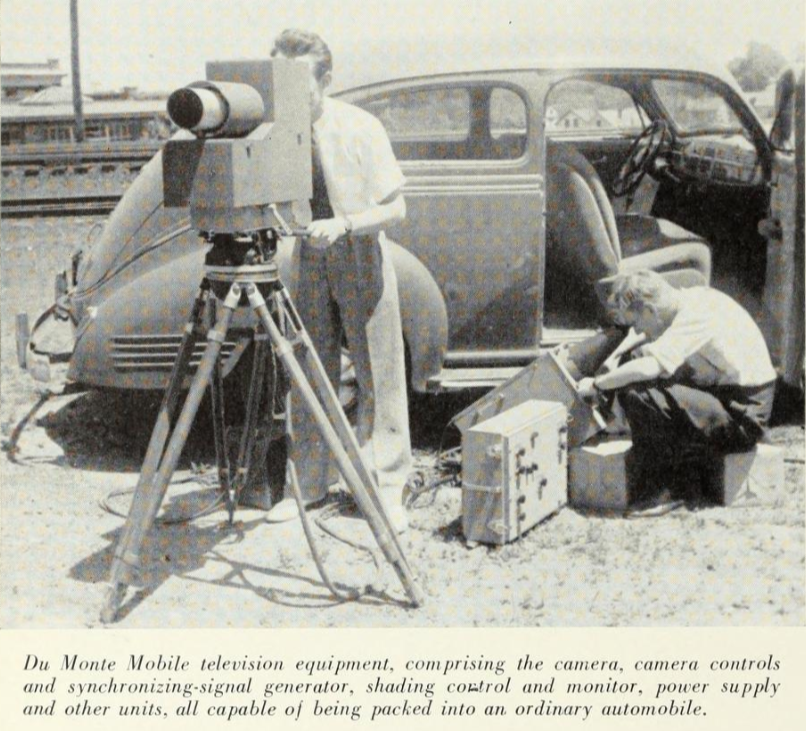
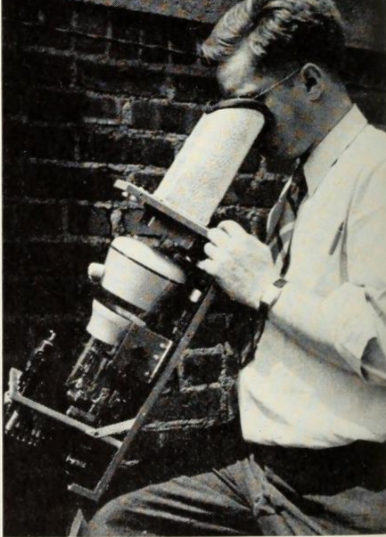
Above is the viewfinder we see in the top photo with the “business end” out of the box. In the box, that is much bigger because of the power supply unit, only the accompanying engineer can see the image which is really not much help to the man behind the camera, but our photo journey continues.
Below is a photo from about a year later (1942 or ’43) that shows DuMont’s new mobile unit that was operated out of their offices and studios at 515 Madison Avenue. Remember, the top photos were taken a month before Pearl Harbor was bombed and shortly after, all electronics manufacturers efforts turned to the war effort…BUT. NBC/RCA, CBS and DuMont all had experimental television stations and DuMont’s W2XWV in New York continued to broadcast on Wednesday and Sunday nights for a few hours.
The image below is most likely from and early evening live broadcast in New York in the summer of 1943. This is most likely the same, single prototype iconoscope camera in the photo above, but notice now, VOILA! The electronic viewfinder is now mounted along the lower left side of the camera, with cords to it’s power supply in the truck in plain site. The next DuMont camera we see will not be this original prototype…it will be their production model that went into service around late 1945 or early ’46.

Below, we have a new casing for the camera and the viewfinder mounted at an angle up the left side for easy viewing and adjustment and in service at DuMont’s KTLA in Los Angeles. -Bobby Ellerbee

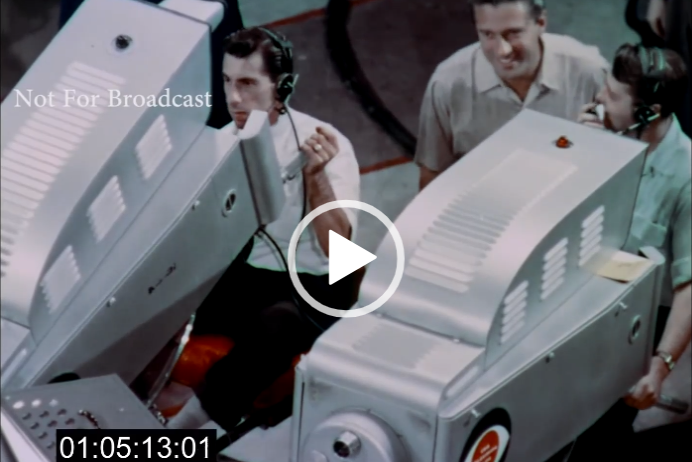
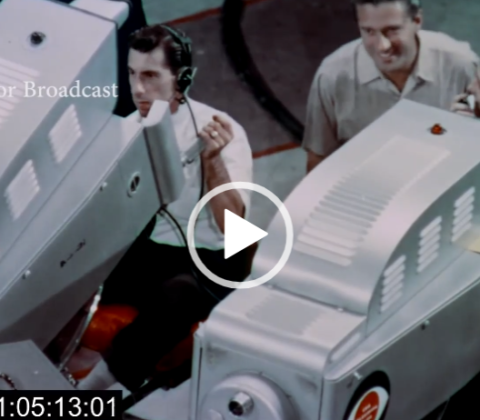
AMAZING CBS COLOR STUDIO 72 NYC…COLOR FILM TOUR
Here is a newly discovered piece of color television history about one of the least known network color facilities…CBS Studio 72 in New York. This is a never aired feature that shows color productions of “The Ed Sullivan Show” and the mystery show “Danger” in 1954.
There are tons of great shots of the RCA TK41s in service and the control room with all the camera control unit apparatus in operation. With the cameras mounted on the old manual PD 1 crank up pedestals and three heavy cables per camera, utility men were a must. BY THE WAY, at the very start, notice the experimental GE mechanical color camera to the left of the introductory speaker. Many thanks to our friend and Game Show Network historian David Schwartz for sharing this.
At the link is a GREAT 24 page CBS Engineering book on CBS Color Studio 72.
https://eyesofageneration.com/cbs-color-studio-72/
ENJOY and BE WELL! -Bobby Ellerbee
A Production Primer By Television’s First Cameraman
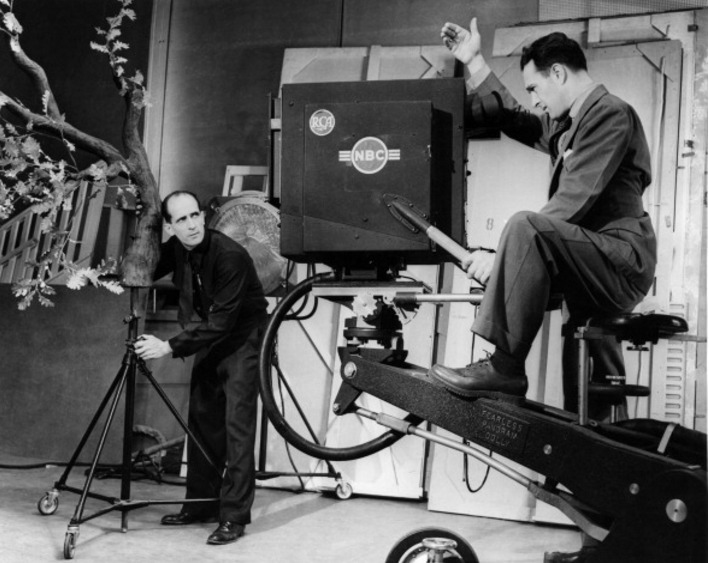
In a photo taken in NBC’s historic Studio 3H, we see Albert Protzman, the first camera person hired to operate RCA’s new all-electronic television apparatus. Studio 3H was the first all-electronic television studio ever built and efforts began by RCA in May of 1935 converted this former NBC radio studio into the epicenter of the world of experimental television in America. Mr. Protzman was there for every step of the way and in 1940 wrote this 15 page article for RCA on just exactly what had to happen for live television to be produced.
By today’s standards, it is very quaint, but remember…this was the very start of television and as Protzman lays out techniques of production, he also lays out the functions of the studio, the control room, special effects, film inserts and more. These are words of a real TV pioneer who, before he retired from NBC in the early 1960s had become of the the network’s top technical directors. Albert’s studio camera partners were (NBC’s second cameraman) Don Pike and (the third cameraman) Heino Ripp who became a legendary technical director in his own right at NBC.
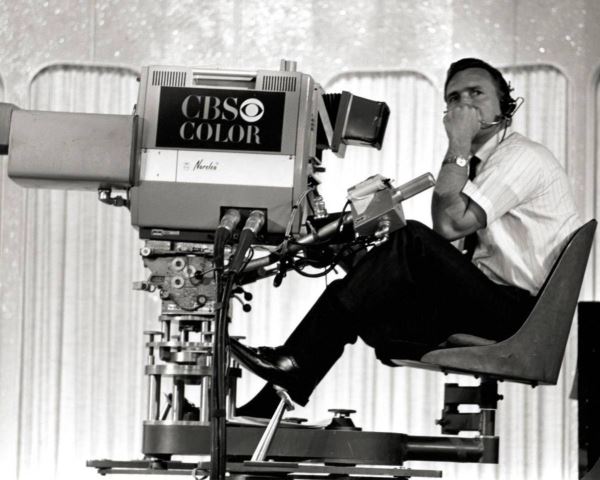
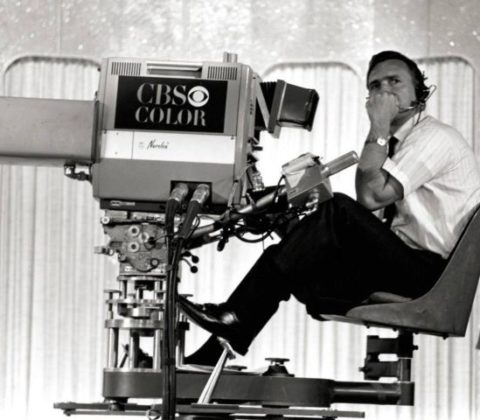
Philips Norelco PC70 Catalog
From the early 1970s, here a copy the 31 page Norelco PC 70 catalog. This was television’s “new kid on the block” camera…the one that gave the big kid on the block (RCA) a run for the money and brought the Plumbicon tube to the forefront. Thanks to our friend Scott Baker for the use of his copy.
-NOTE: This is a High-Resolution document and may take a moment to load.


The Rarely Seen GE PE 25 Color Camera
Thanks to our friend Martin Perry, this catalog is the only piece of GE information we have ever seen on this rare color camera. It was preceded by the GE PE 15 model, of which there were less than a dozen made. There may have been as many as 20 to 25 of these PE 25 cameras manufactured and the successor was the GE PE 250. That we know of, there are no PE 25 survivors. Take a look at this rare piece of color history. – Bobby Ellerbee
October 10, 1949…The First Ever Network Color Broadcast Airs
The cameras you see here are what RCA referred to (this first color camera design) as the Princeton Cameras, as they were designed and built at the RCA Laboratory in Princeton NJ.
In the rare photo above, we see singer Gladys Swarthout, performing for the dignitaries during the color test, just before “KFO” was scheduled to air on October 10, regardless what the back note says.
Below is the special half hour color presentation of the broadcast as captured on kinescope in New York. The notes on the video are good too if you click the watch on youtube button at the lower left corner.
On this day in 1949, NBC broadcast “Kukla, Fran & Ollie”, live and in color from their Washington DC studio at The Wardman Park Hotel.
The 15 minute show was usually done in Chicago, and in black and white, but RCA had brought them to town for a week of experimental demonstrations to congress and the FCC. That week, each day was filled with short color demonstrations that included all kinds of on-camera talent in the closed circuit broadcasts.
The only people that would have been able to see it in color were there, and at RCA Princeton, but not a single comment was ever received from the viewing public about the color image broadcast to their home sets, which certainly goes a long way in proving the system’s “compatibility”.
‘Hour Glass’…A Television First
This show was network television’s first rehearsed, non-reality program. It was a one hour variety/sketch comedy show hosted by Helen Parrish. Parrish had been a child film star and she became the first popular TV star. With the lessons learned and a new host and sponsor, NBC would bring this show back in 1948 in a tighter and more structured form as, ‘The Texaco Star Theater’ with Milton Berle. ‘Hour Glass’ debuted on NBC in television’s first ever “fall season” and ran from 8 till 9 PM on Thursday nights from May 8, 1946 till March 6, 1947. In 1946, NBC only had 10 shows on the network which covered NYC, Schenectady and Philadelphia but that was twice as many as the only other network offering television and that was Dumont. On Thursday nights, ‘Hour Glass’ was preceded on the network by the 10 minute ‘Esso News Reel’ at 7:50 and followed by local programs. ‘Hour Glass’ pioneered sketch/variety TV, and was the most ambitious and expensive production yet with big production numbers, chorus girls, a band, famous guest stars, and more with the show’s sponsor pouring in over $200,000 for the show’s nine month run.
The program was produced by the J. Walter Thompson agency on behalf of Standard Brands for their Chase and Sanborn and Tenderleaf Tea lines. ‘Hour Glass’ featured different performers every week, including Peggy Lee and, in one of the first examples of a top radio star appearing on network television…Edgar Bergen and Charlie McCarthy in November 1946. The show also showcased filmed segments produced by Thompson’s Motion Picture Department; these ranged from short travelogues to advertisements. Every episode also included a ten minute drama, which proved one of the more popular portions of the show.
“Although Thompson and Standard Brands representatives occasionally disagreed over the quality of individual episodes, their association was placid compared to the constant sniping that was the hallmark of the agency’s relationship with NBC. It started with unhappiness over studio space, which Thompson regarded as woefully inadequate”*!
The tension escalated when the network insisted that an NBC director manage the show from live rehearsals through actual broadcast. The network was similarly displeased that Thompson refused to clear their commercials with NBC before air time. Parrish left the show in November to return to Hollywood and was succeeded by a much less popular host, Eddie Mayehoff. In February 1947 Standard Brands canceled ‘Hour Glass’. They were pleased with the show’s performance in terms of beverage sales and its overall quality, yet were leery about continuing to pour money into a program that did not reach a large number of households. The strain between NBC and Thompson played a role as well. Still, Hour Glass did provide Thompson with a valuable blueprint for the agency’s celebrated and long-running production, Kraft Television Theater.
* quoted from The Museum Of Broadcast Communications, “Encyclopedia of Television”.
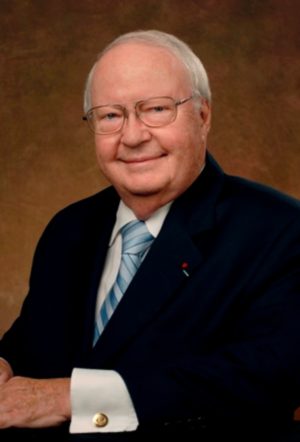

My Conversation with CBS VP Technology, Joe Flaherty…RARE HISTORY!
Dr. Joe Flaherty was the Senior Vice President of Technology at CBS and at the bottom of my story is an article with industry colleagues sharing their memories of the icon of television innovation.
There are few that have seen more television history than Joe Flaherty. There are fewer still that have made as much television history! I will not try and cover all that here, but will instead bring to light some interesting background surrounding several major events in CBS and broadcast history. As I try and boil down over an hour of conversation, I may do some skipping around from topic to topic, and our fist topic is the backstory on Norelco.
According to Joe, “If CBS is the Tiffany network, the BBC is the Gold network”. Although CBS had a couple of hundred engineers in research and development, the BBC had three times that many. In the early 60s, Dr. Flaherty, with a degree in physics was already moving up the ladder and was sent to England to see what he could learn form the BBC about some new black and white cameras they were using.
They were Phillips cameras and had this new Plumbicon tube in them that made great pictures. While there, he called Phillips and they sent a plane for him. He went to the plant in Holland and while there, asked if the Plumbicon would work for color. They had not given it much thought, but after that visit, they did. The result was the PC 60. In early 1964, Joe went back to Holland to take a look. There were problems with the red channel registration on those early PC 60s, but Joe was impressed and bought all 25 of them. Unfortunately, the plant in Eindhoven could only make 25 a year, so he bought a years worth of production. Soon after, Phillips set up shop in New York and began making the PC 70 there and at a much faster clip. CBS had ordered the first 75 and delivery began in 1965.
This was a busy period for Joe and CBS. In 1952, CBS bought a dairy depot from Sheffield Farms and had used it mostly for scenery storage, but with the studios at Grand Central Terminal getting cramped, and wanting to consolidated some of the many broadcast theaters throughout Manhattan, a change was needed. William Paley put Joe in charge of converting the building to the CBS Broadcast Center. By 63, some of the TV studios were up and running and master control moved from Grand Central in late 64 completing the move. With his intimate understanding of the Norelco color regime which was to come, he was the perfect man for the job.
Although the RCA TK10s and TK30 came long before Joe got to CBS in 1956, I did ask him about the unique striped band around the top of most of the cameras. For a long time, no one knew or could say why they were there. A few years back, Pete Fasciano, who developed the Avid editing system, was helping me with the art work for my TK11, which I dressed as a CBS network camera. When laying our the black horizontal stripes at the top and bottom and the alternating grey and white vertical bars, Pete realized this was actually a grey scale test pattern. I told Joe the story, he laughed and confirmed our theory. The amplitude was adjusted using the black and white bars and the frequency adjusted using the grey bars.
Speaking of grey…now we know why all the CBS equipment was painted ‘navy grey’. Joe could not remember the name, but one of the early chief engineers for the television network was an former admiral in the Navy. You can see where this is headed can’t you? Yes, it was his idea to paint all the equipment ‘navy grey’ so it would all match. This started in the mid 50s. Many theories have abounded, like ‘eye acuity’ and more, but…
By the way, one of the financial considerations involved in management signing off on the 100 camera Norelco purchase involved man power. For many years, CBS upper management referred to the RCA color systems as ‘NSCT’ systems, which stood for ‘Never The Same Color Twice’. For network quality, the RCA TK41s and color telecine chains needed one video man to shade each camera and chain. It was thought that with the Norelco cameras, one man could shade 6 cameras at a time. I’m not sure how that worked out.
William Paley would ask Joe to lunch about 4 or 5 times a year. Each meeting, Paley would ask “What are we not doing that we should be doing?” That’s a great question for a CEO to ask and Joe always had to do his homework before each meeting. One of those big ideas was digital and HDTV, which we’ll get to soon, but first, let’s go back to the early 60s and another of Joe’s big ideas…ENG cameras.
Joe said one of the great things about CBS news was, “They were always willing to try something that almost worked.” This is where the ENG cameras come in. Even before CBS became involved with Ikegami in 1962, they had built a couple of ENG cameras in house. Last month, we had trouble identifying a CBS ENG camera at a Gemini space launch…I’m betting that was one of the CBS/Ikegami custom built cameras.
CBS News wanted to go with ENG cameras but there were still a lot of kinks to be worked out with the cameras and with a mobile video tape recorder. In the early 60s, Joe began spending time in Japan where CBS had an engineering office. He worked with Ikegami on the cameras, and soon after with Sony on the VTR. To test this all out, the CBS owned station in St. Louis, KMOX became ground zero for ENG production. The confidential agreements between CBS and Ikegami and Sony paid off and long before the RCA TK76 came out in 1976, CBS was using custom made, Ikegami ENG cameras. As is noted in his bios, Joe was the real pioneering power in the field of ENG.
He is also called ‘The Father of HDTV’ and it’s true. NHK in Japan had come up with the idea and Joe was there collaborating with them in 1971. There are many online articles about his many contributions and I’ll let you Google those, but here is an interesting backstory of one of the fist demonstrations.
Francis Ford Coppola was there and told Joe that, in his opinion, HDTV was better than 35mm film prints. The 35mm negatives were better than early HD, but when prints are made for distribution, the resolution and colors break down. Among the early problems was the difficulty in seeing the HD broadcast signal as the early HD receivers were not up to par yet. This is reminds me of the problems at RCA in the early days of color. They had to build a monitor as good as the camera to see what they had.
Jumping to one more quick item, I had long wondered which CBS studio had the Dumont cameras. As it turns out, 4 studios had them…Studios 53, 54, 55 and 56 at Liederkrantz Hall were all Dumont equipped. Oh yes, and Joe is the only man to have ever redone The Ed Sullivan Theater twice! Once in 1965 for color, and once again when David Letterman came to CBS.
Dr. Joe passed in 2018, but he is well remembered! https://www.twice.com/industry/remembering-dr-joe-flaherty
TV Technology, a TWICE sister publication, reached out to some of his industry colleagues for their remembrances of Joe.
Peter Fannon was president of the Advanced Television Test Center and recently retired after a long career with Panasonic.
“It is very hard to imagine a television world without Joe Flaherty. He was—over six decades—a persistent force for global technological progress and industry advancement. Whether responsible for conceiving, building, or integrating new technologies and systems, Joe was a master at inspiring—and yes, sometimes terrifying—others in order to accomplish with him the progressive changes he could foresee would improve television for both content creator and broadcast company, for both TV viewer and online consumer alike.
His personal drive was, to be sure, formidable. He was relentless in pursuit of the new and better, the smarter and more efficient ways in broadcast and satellite spectrum use, studio and newsgathering design, camera and recording technologies, computer-generated imaging, facilities and network interconnection, and display technologies of all sorts. Throughout his career he supported or led research and development in-house, and he worked tirelessly with manufacturers around the world to bring to life new concepts in all of these arenas. He spent uncountable time traveling and working with broadcasters in all parts of the globe, and in international standards bodies, seeking to align ever-improving television technologies in order to effect easy global program exchange, and to spur competition for the best solutions whatever the issue.
Most famously, it was Joe Flaherty who first propelled the notion of high-definition TV in the United States, calling up all his persuasiveness to rally engineering, business and then political forces to bring “advanced television” to American broadcasting. Under the aegis of the FCC’s Advisory Committee on Advanced Television Service (ACATS)—which he had lobbied to have created—he chaired the all-important Planning Committee, which set out the technical and operational criteria for what became, barely a decade later, the world’s first all-digital HDTV terrestrial broadcast system.
And during that time he gave time and attention to every advanced TV system proponent in order to solicit the best ideas; participated in every Advisory Committee meeting and activity; served on the Board and technical committee of the Advanced Television Test Center; spoke frequently to domestic and international gatherings about the television of the future; and lobbied Members of Congress, Commissioners of the FCC, and both White House and Federal agencies’ leaders on the need and means for a smooth, nationwide transition to the new system.
It will be impossible indeed to see and enjoy television at all without thinking often of the passion, commitment and contributions of Joe Flaherty to making it all happen.”
Richard Wiley is former chairman of the FCC, chairman of the Advisory Committee on Advanced Television and is partner at Washington, D.C., law firm Wiley Rein.
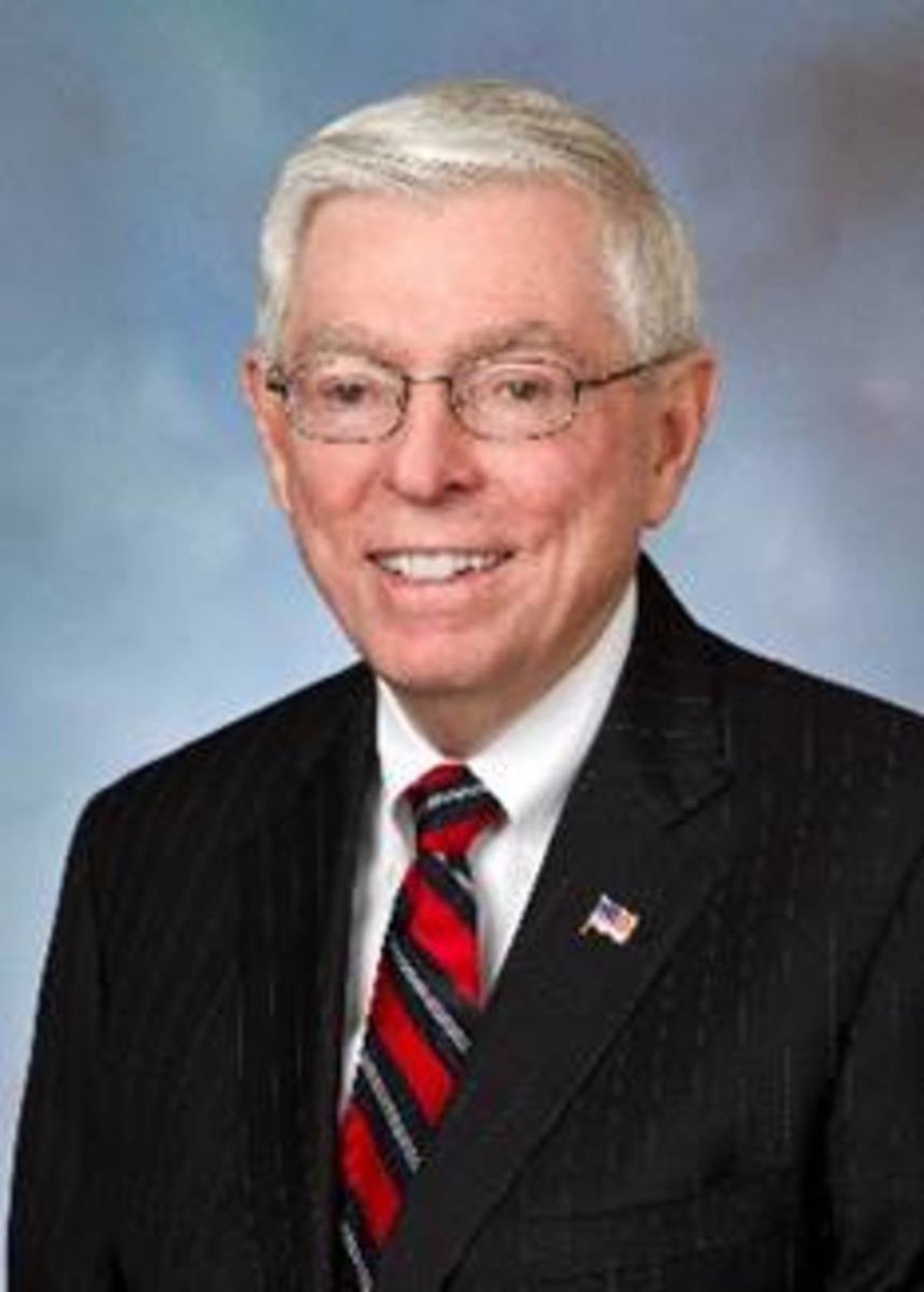
“I worked closely with Joe during the eight-plus years of ACATS (FCC’s Advisory Committee on Advanced Television Service). He always kept his eye on the end game—high definition television. We had people suggesting systems that were lesser than HDTV but that was never going to be satisfactory from his standpoint. He helped develop the rapid deployment of HDTV on a worldwide basis and I learned a lot by reading a number of his papers.
He was a true visionary and could find pragmatic solutions to the innumerable technical problems that we confronted during those eight years. For example, when we had to test these different systems, he went to the NAB to lobby for developing the Advanced Television Test Center—he was instrumental in getting it built.
I went with Joe on many international trips and everybody knew him, he was the ambassador for television at large. He was known worldwide and I don’t think anyone else had that status—he was a unique figure. He was soft spoken but determined. He might have ruffled some feathers from time to time but he had a dream. He and Mark Richer were the two engineers I relied on the most because they would always give me the unvarnished truth as they saw it.”
Larry Thorpe is Senior Fellow at Canon U.S.A. and spent more than 20 years at Sony Electronics pioneering the development of HDTV and digital production technologies in the U.S. broadcast and motion picture industries.
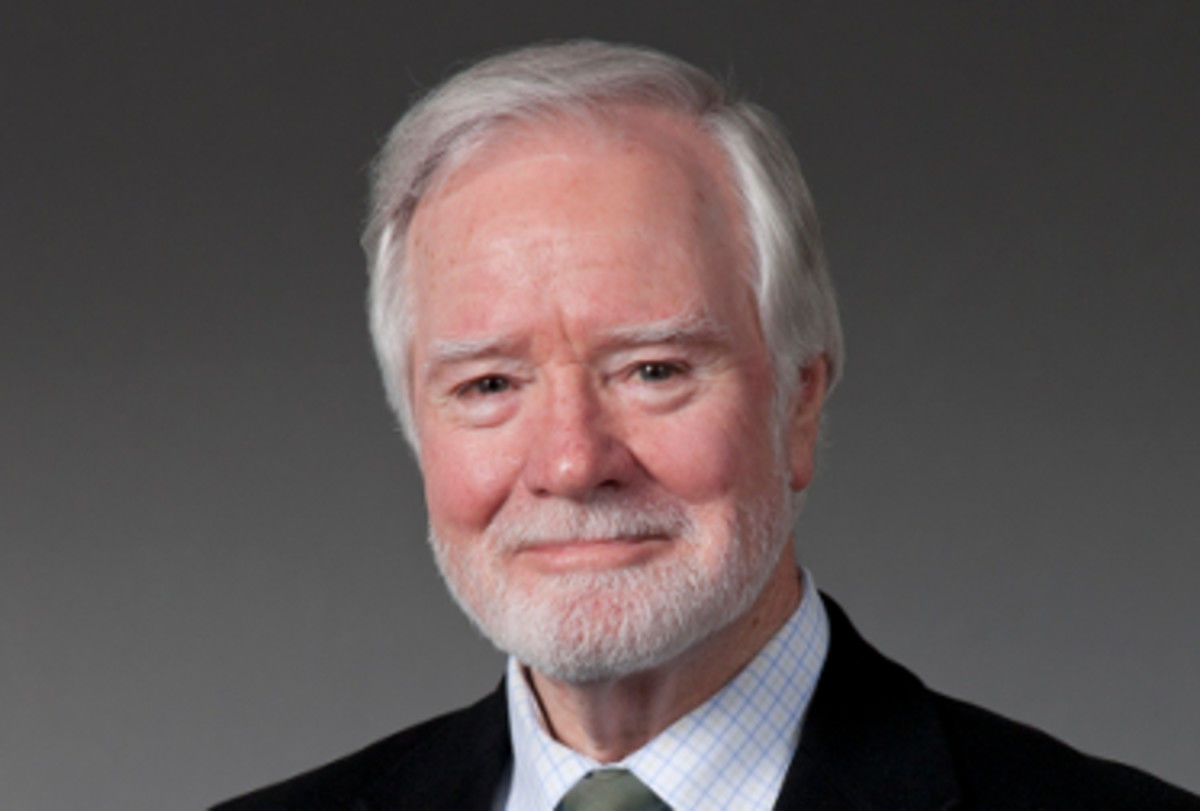
“My positive response at an initial meeting with Joseph Flaherty in the mid-1970s was probably the fact that we were both of modest physical stature. But I was soon to learn that his industry stature soared far above my own. Maybe it was my being Irish that formed the early bond between us (he regularly vacationed in Ireland). While that manifested itself largely in cordiality over the next decade whenever we sporadically met, it was to blossom into a working bond in the early eighties when then Dr. Flaherty learned that I was Masahiko Morizono’s point man on driving Sony’s HDTV agenda in the U.S. The very close relationship between those two giants was forged more than a decade earlier when Joe Flaherty’s drive behind electronic newsgathering was flanked by Morizono-san’s drive behind ENG cameras and recorders—first the Umatic and later the Betacam.
At a time when HDTV was looked askance at by most broadcasters, Joe Flaherty had instantly seen the future of video imaging and indeed the future of broadcasting. If he was relentless in his drive on ENG, he was positively titanic in his unwavering leadership on HDTV. His vision of 1080/60.00 as a potential worldwide HDTV production standard never faltered over the next decade and a half. I spent countless hours with Joe at endless formal meetings of the various HDTV standardization groups, the multiple strategy sessions within CBS, and supporting the never-ending demonstrations that he organized at every conceivable venue around the globe. While the latter could at times create tensions between us, Joe would always make things right with a fine-dining lunch or dinner.
Leadership emerges under various guises but Joe Flaherty based his on a sharply focused determination that was at times disguised by his remarkably quiet voice. Entanglements with the separate and competing HDTV agendas of European broadcasters, the computer industry, and Hollywood never daunted Joe. His international diplomacy was unwavering as he sought to persuade all to his mission of a unified HDTV standard. And indeed, Joe could be uncannily persuasive. The emergence of the worldwide 1080-line HDTV standard (albeit at international frame rates) is testament to his persistence.
I was sad to see Joe fade quietly from the world scene over the past decade—but impressed and heartened by the fact that he was in his eighties when he did start to withdraw. Everything he dreamed about over the past 50 years—from ENG to HDTV—are today colossal global realities. Joe Flaherty can surely rest in peace having left a legacy of jobs superbly done. Goodbye, my mentor.”
Mark Richer is president of the Advanced Television Systems Committee.

“Dr. Flaherty’s lifetime commitment to the advancement of television technology was extraordinary. Among his many contributions to the industry was the pivotal role he played in the formation of ATSC in 1982. He served on the ATSC Executive Committee and Board of Directors until 2010 when he was named to the honorary “Member Emeritus.”
Dr. Flaherty’s unwavering commitment to the standardization of HDTV was contagious, motivating the industry to develop the highest quality system possible. He had the vision to understand that the specifications for HDTV should not be limited by the capabilities of the cameras and displays available at the time.
Joe pushed industry groups to establish long term strategies often quoting one his favorite proverbs, “If you don’t know where you’re going, any road will take you there.”
Gary Shapiro is president/CEO of the Consumer Technology Association (CTA). The group issued the following statement shortly after Flaherty’s passing.
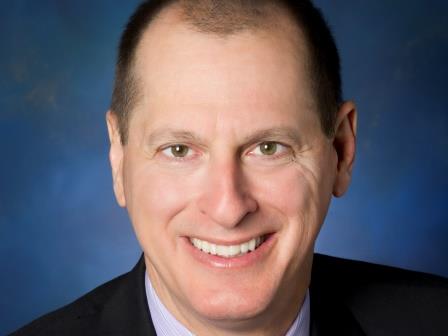
“Joe Flaherty was a visionary who believed the American HDTV standard should be the highest-possible quality. Throughout his decades as a CBS executive, he advocated for better national and global standards for all broadcasters. Joe often called me and urged me to take a strong position in favor of broadcast quality, and I never failed to heed his advice. Today, people around the world enjoy a richer TV viewing experience than ever, in no small part because of Joe’s focus on excellence. We have lost a true industry legend.”
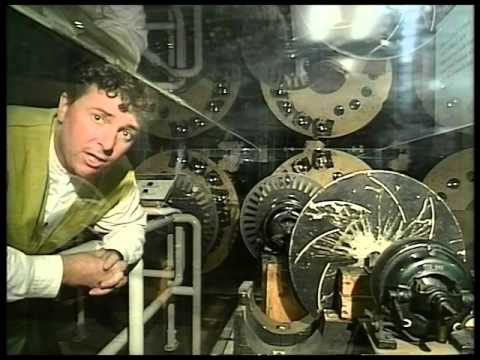
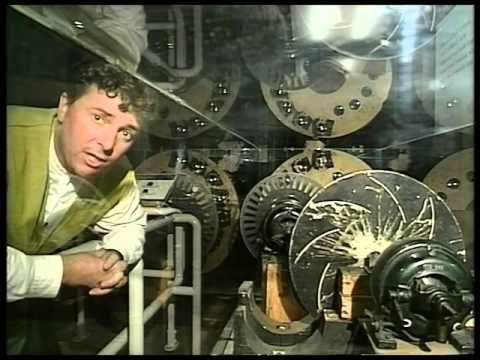
FIRST EVER VIDEO RECORDING…September 20, 1927? YES!
FIRST EVER VIDEO RECORDING…September 20, 1927? YES!
Until yesterday, I had never heard of this and found it hard to believe, but here is the amazing proof laid out, fittingly…in 3 video reports.
In the 1996 report (top video), a single disc of the John Logie Baird video record or Phonovision had just been discovered. As you’ll see, no one had ever seen it, because even Baird had not created a way to play it back, so another Scotsman had to build a way to see it, which is covered there too.
The images were from 1933 and showed The Paramount Astoria dancing girls, shot with a horizontal 30 scan line mechanical system. In the 1998 story (bottom video), 11 more Baird discs have been found, with the earliest dated September 20, 1927. This report includes bits from those newly discovered discs, and at the end there is interesting archival film of Alexandra Palace being made ready for the tests of the competing Baird mechanical system, and Marconi-EMI’s new electronic system.
For more, here is the site of the man that built the playback machine with a great deal more on Phonovision. http://www.tvdawn.com/earliest-tv/phonovision-experiments-1927-28/
You learn something new every day, and after all…isn’t that what life is all about? -Bobby Ellerbee
CBS Broadcast Center…1964 Introduction Book
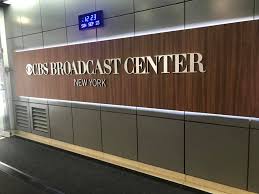
This 60 page book was presented at the 1964 NAB Convention to introduce the new CBS Broadcast Center in New York. Half of it is a description of how the building was converted and what is inside – the other half is full of illustrations and photos of the magnificent new facilities. I had heard about this book, but had never seen one till now, and I am pleased to share this with you.
This came from our friend Craig Cuttner, who just retired as Senior VP of Technology Development and Standards at HBO. Craig was with CBS before joining HBO in ’82, and after 36 years in the business, we wish him happy trails as he returns home to Atlanta. -Bobby Ellerbee
NBC’s Legendary Technical Director…Heino Ripp
FIRST, Don’t miss this! The Television Legends Interview Series taped six half hour segments with Mr. Ripp and the first of the series is linked below.
https://interviews.televisionacademy.com/interviews/heino-ripp?clip=102062#interview-clips
In the photo above, we see Heino starting his career in Studio 3H behind an RCA A500 Iconoscope camera. Below, he is literally the “right hand man” to another legend, Dwight Hemion (no headset), who is directing ‘The Perry Como Show’ at The Ziegfeld Theater.
Mr. Ripp was born with a mild deformity in the fingers of his left hand which kept him from serving in WWII. This allowed him to keep his new job at NBC, which he began in the early ’40s. All through the war years, he was there…learning and innovating.
Heino moved from the studio to the control room and soon became one of the network’s top technical directors….a role that he would continue in until his last years with NBC, in which he served as the TD on ‘Saturday Night Live’.
You name it, he saw it! When television took off after the war, Ripp was right in the middle of the biggest entertainment and technology explosion ever seen. Every big, live NBC show you can think of, Heino was there for.
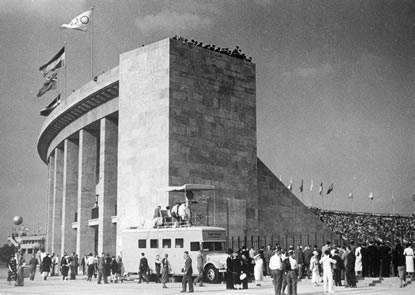

Amazing New Berlin Olympics Television Information
If you are lucky, you learn something new every day, and today, we are all lucky! I had no idea that what you are about to read and see here ever happened, but thanks to yesterday’s post on the first mobile units, we have fascinating new images and video to share.
Thanks to David Breneman and James Freeman, we now know that there was indeed a mobile unit in service at the 1936 Berlin Olympics…BUT…not in the classic sense, of being equipped with live electronic video cameras shooting the action.
Instead, the German unit was an “intermediate film” television apparatus, which I had never heard of either.
It works this way…a normal cinema camera, mounted on a transport van, initially records the footage on film, which is sent down the camera’s light tight pedestal into the van. There, the film is immediately developed inside the van and then run through a flying spot scanner camera (so called because it moved a focused beam of light back and forth across the image), and electronically converted from a negative to a positive television image. Scenes from the just developed film could be broadcast with a delay of about a minute.
In this video, you can see the Telefunken cameras and the Berlin van, with an animated diagram of how it works. The photos include a shot of the van, a diagram of the operation, US champion Jessie Owen and a Telefunken Canon camera, and at the end a few seconds of film shot by the van top camera.
John Logie Baird began developing the process in 1932, borrowing the idea of Georg Oskar Schubert from his licensees in Germany, where it was demonstrated by Fernseh AG in 1932 and used for broadcasting in 1934.
The BBC used Baird’s version of the process during the first three months of its then-“high-definition” television service from November 1936 through January 1937, and German television used it during broadcasts of the 1936 Summer Olympics. In both cases, intermediate film cameras alternated with newly introduced direct television cameras.
The intermediate film system, with its expensive film usage and relatively immobile cameras, did have the advantage that it left a filmed record of the program which could be rerun at a different time, with a better image quality than the later kinescope films, which were shot from a video monitor.
Television tubes developed by Farnsworth and Zworykin in the United States, and by EMI in England, with much higher sensitivity to light, made the intermediate film system obsolete by 1937.
I had no idea that motion picture film could be developed that fast, which brings up all kind of questions about NBC’s mad dashes to get kinescope film turned around for rebroadcast on the west coast.
Now…back to Berlin. In addition to the mobile unit camera, three state-of-the-art Iconoscope cameras are also used, among them Telefunken’s ‘Olympic Cannon’, which earns its nickname due to the large lens. There was also a single Fernseh experimental camera there using the Farnsworth Image Dissector tube.
There was a built in control room in the stadium, which fed the coverage to two special lines that went directly to the Berlin TV tower for broadcast. Therefore, there was no need for an electronic television remote unit, in the classic sense.
These cameras broadcast eight hours of moving images per day. There are 75 television sets in Berlin, most of them in the 27 public television parlors. There are two other parlous in Potsdam and Leipzig. At the time, the television broadcasts are sensational events for the audience. But they are barely comparable with today’s public viewing: the screens on the television sets are barely larger than a modern tablet PC display. Thanks for all the help in bringing interesting new information to light! -Bobby Ellerbee
April 17, 1967…50 Years Ago, “The Joey Bishop Show” Debuted
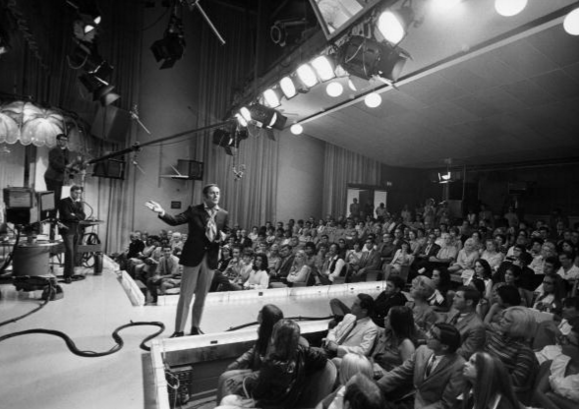
Here is the story I wrote for the Archive Of American Television site…home of the Emmy TV Legends video collection and histories. Enjoy and share! It’s quite an interesting story! -Bobby Ellerbee
April 14, 1956…Videotape Recording Debuts; Ampex VR-1000 Unveiled
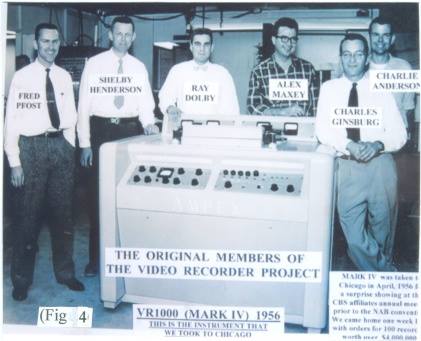 On April 14,1956, this prototype Ampex VTR called “Mark IV” started a whole new era in television. In the photo, you see the Ampex Videotape Team…the men who created the VR-1000 and revolutionized broadcasting. Pictured with this six man team is the unit Ampex took to Chicago for the legendary demonstration at the 1956 NAB Convention, to the amazement of all who attended.
On April 14,1956, this prototype Ampex VTR called “Mark IV” started a whole new era in television. In the photo, you see the Ampex Videotape Team…the men who created the VR-1000 and revolutionized broadcasting. Pictured with this six man team is the unit Ampex took to Chicago for the legendary demonstration at the 1956 NAB Convention, to the amazement of all who attended.
In the team photo, Fred Pfost is on the far left. Here is Fred’s description of the events of the week of the demonstration in which Ampex took almost 100 orders for the $50,000 VR-1000.
“On the Saturday, April 14, two days before the convention started, we demonstrated the recorder for about 300 CBS affiliates meeting at the Conrad Hilton Hotel. I recorded (from behind a curtain) the opening speech of Bill Lodge, V.P. of CBS, who described all the activities that CBS had been involved in during the past year, and his announcement of a big surprise, that was about to happen. After I rewound the tape and pushed the play button for this group of executives, they saw the instantaneous replay of the speech.”
“There were about ten seconds of total silence, until they suddenly realized just what they were seeing on the twenty video monitors located around the room. Pandemonium broke out with wild clapping and cheering for five full minutes. This was the first time in history that a large group (outside of Ampex) had ever seen a high quality, instantaneous replay of any event. The experience still brings tears to my eyes when I recall this event.”
“During the week of the convention, the Ampex display area was packed, all day, every day. Orders came so fast and furious, that the Ampex sales staff was writing orders on cocktail napkins.”
It took Ampex a year to fill just the orders taken at the convention. If memory serves me right, CBS got the first 5, NBC got the second 5 and ABC, the third 5, with more on order for all 3 networks. I think CBS put 3 at TVC, and had 2 in NYC. NBC put 3 at Burbank, 1 in NYC and 1 went to RCA Labs in Princeton, with RCA and Ampex starting to share RCA’s color tape ability. I think ABC put 3 at Prospect and 2 in NYC. -Bobby Ellerbee
